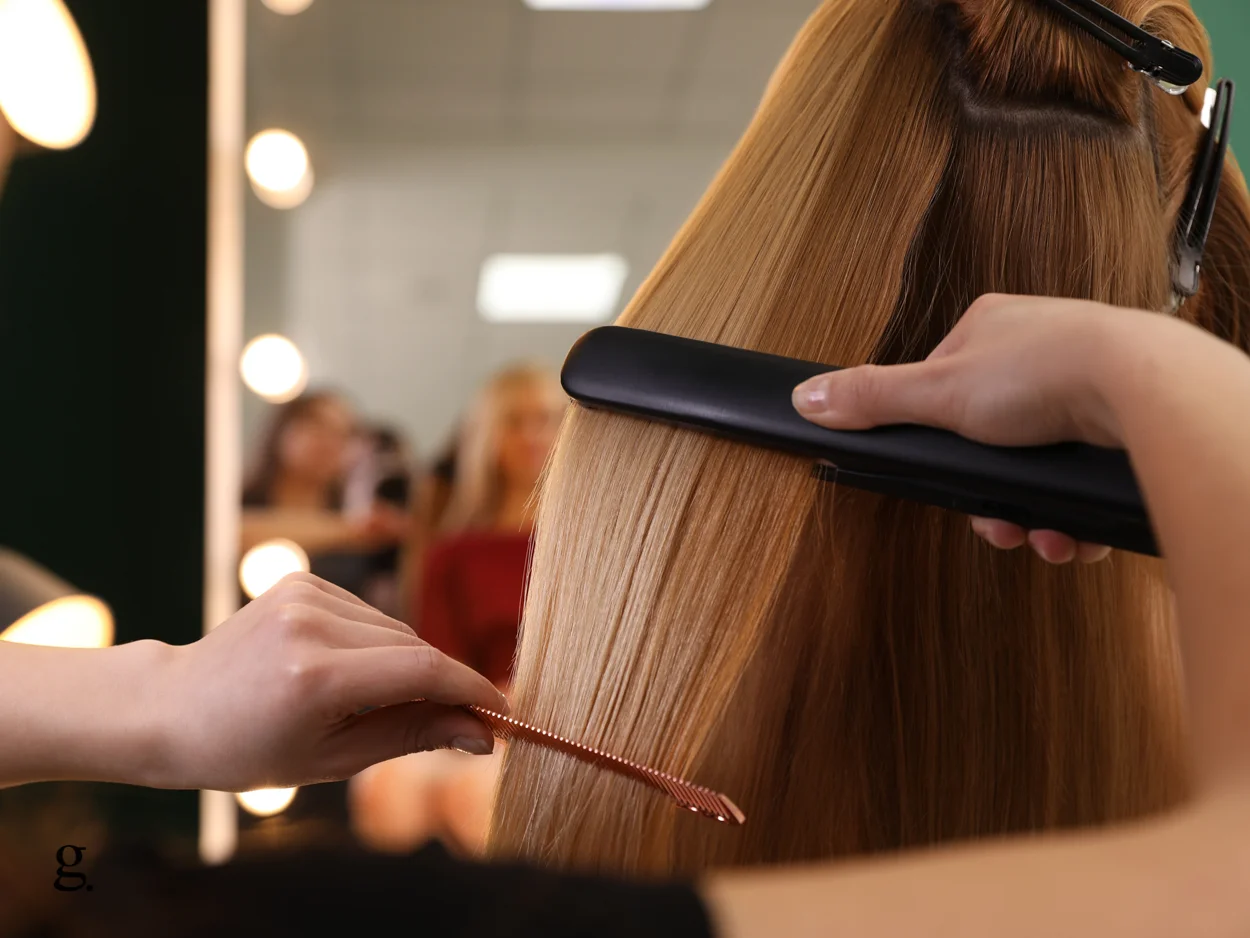We’re always trying to reinvent our style, especially when it comes to hair. From curls to perms, to ultra straight locks, all the way to dreads, the possibilities are endless.
However, achieving these bold styles often involve a lot of hard work and toil, and usually the helping hand of hot styling tools such as straighteners, curling tongs, and blow-dryers.
This makes the potential for heat damage very real (which occurs around 130 °C (266 °F), so you absolutely need to take steps to minimize the risk if you care about your hair’s health.
This is where heat-protectant products come in. Can they really help prevent your hair from devastating heat damage? We looked into it.
How heat-protectant products work
Due to the ever-expanding haircare market, there is a wide range of effective heat-protectant products available that claim to shield the hair from harmful temperatures.
The most popular are spray-based (liquid solution) and cream-based.
These products work by coating your hair strands with a thin layer of their heat-protection ingredient(s), which are usually silicone-based polymers, to help soften the blow of heat styling, however, they do not completely prevent heat damage.
Effectiveness varies from product to product depending on which ingredient(s) are used within the formula. One research paper we found states these ingredients can help reduce hair decomposition by 10-20%. ((https://www.researchgate.net/publication/289528396_Thermal_degradation_of_hair_II_Effect_of_selected_polymers_and_surfactants))
While that may not seem much, some protection is better than none.
When is the best time to use heat-protectant haircare products?
It’s crucial to use heat-protectant products at the right time to best shield your hair from heat damage. It may seem obvious, but you must always apply the spray or cream before you use any hot styling tools.
For sprays, we’d suggest you give 3-5 minutes to ensure the product has sufficient time to take hold. For creams, you’ll need to allow a little more time to pass as it’s typically a little slower absorbing.
You’ll know your hair is ready for styling when you can no longer feel or see the product in your hair.
Heat-Protectant Spray vs Cream
Choosing the right heat protection product for you is also important. Below, we’re explaining the differences between creams and sprays, and which we think is better.
Facts about heat protectant cream
With a thick, oil-in-water emulsion base, a heat protectant cream looks and feels like any traditional face or body cream.
The cream is applied by hand to either wet or dry hair and is thoroughly massaged into the strands until the designated area is suitably covered.
From there, the formula works to encase itself around the hair. Once fully set, your hair is ready to be styled.
Heat protectant cream pros
- Can help reduce damage caused to your hair by extreme heat
- Much more workable when compared to spray
- Cream typically provides better coverage
- Cream-based products may sometimes contain more hair-benefiting active ingredients (always check labels)
Heat protectant cream cons
- Could potentially make hair feel greasy
- The cream may clog scalp pores
- Accidentally using too much cream can cause build-up
- Takes longer to absorb/set when compared to sprays
Facts about heat protectant spray
Emulating and operating like common hairspray, heat protectant spray is a quick and easy way to protect your hair if you need to save time.
With a water-based formula, the spray is squirted from the bottle onto the hair before it is rubbed in more thoroughly with your fingers. The ingredients then layer the follicles and provide strong protection against hot styling tools. The spray is quick to apply and is a popular choice for men and women who have busy lifestyles.
Heat protectant spray pros
- Can help reduce damage caused to your hair by extreme heat
- Superior ease of use and flexibility compared to cream
- Very convenient
- Fast absorbing
Heat protectant spray cons
- Could potentially make hair feel greasy
- It may not offer as much heat protection compared to cream
- Over-application could lead to hair feeling stiff and straw-like
Other ways of mitigating heat damage to your hair
For most of us, using heat-styling tools is just a part of our morning ritual. Rarely do we stop and think that the actions we’re taking are actually destroying our hair.
Over-styling with heat tools is a good way to totally ruin your hair. Apart from inducing uncomfortable dryness, which in turn leads to brittleness, split ends, breakage, and frizz, heat can also impact the long-term health and strength of the hair overall and lead to increased hair fall.
This is the last thing we want as we age, as our hair naturally becomes weaker anyway. It’s never been more important to take good care of your hair.
Reduce the temperature of your straighteners
This is probably the biggest thing you could do. If you’ve got hair styling tools that allow you to adjust the heat, drop it below 130 °C (266 °F) – this is the threshold at which the majority of hair damage (also called hair decomposition) occurs.
While it is true that the hotter your tools, the faster the results are, you can still achieve the same, or similar, results on a lower heat setting if you just allow a little more time.
If your styling tools do not have any heat-adjustment options, it may be time for an upgrade.
Use water, not heat
It may surprise you to learn that water sometimes works just as well as heat when it comes to styling your hair!
Both water and heat work to break down the hydrogen bonds in your hair, allowing it to be shaped and styled.
When your hair drys, these bonds begin to reform, locking in your new style! This method is perfect for curls and waves – not so much for straightening, however.
We admit that allowing the necessary time for your hair to dry out into the style you want isn’t always convenient, but if time is on your side, then why not give it a go and spare your hair the heat treatment?
Stop over-styling; go natural!
It can be tempting to spend forever on your hair, making it look perfect, but you should also be asking yourself if it’s worth the toll!
Our experts recommend that you style appropriately, and only when required. Ask yourself, do you absolutely need your hair to look completely flawless every single day, or are there certain days you could rock the au natural look?
In summary
Heat-protectant products are designed to lessen hair decomposition caused by styling at extreme temperatures. The main study into these types of products showed they helped reduce damage by around 10-20%.
While we admit that doesn’t seem like a lot, but over a lifetime of styling it all adds up.
We would never recommend styling without a heat-protectant product in your haircare arsenal. Additionally, these products are fairly cheap to buy too.
To further reduce heat damage to your hair, turn down the heat on your styling tools, and only style when required!

